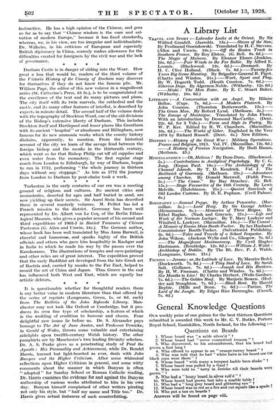Turkestan in the early centuries of our era was a
meeting ground of religions and cultures. Its ancient cities and monasteries, deserted for ages and half buried in sand, are now yielding up their secrets, Sir Aurel Stein has described them in several masterly volumes. M. Pelliot has led a French mission to the district. Germany has been well represented by Dr. Albert von Le Coq, of the Berlin Ethno- logical Museum, who gives a popular account of his second and third expeditions of 1903-5 in Buried Treasures of Chinese Turkestan (G. Allen and Unwin, 18s.). The German author, whose book has been well translated by Miss Anna Barwell, is cheerful and humorous, and speaks highly of the British officials and others who gave him hospitality in Kashgar and in India to which he made his way by the passes over the Karakorams. The illustrations of temples and cave-paintings and other relics are of great interest. The expedition proved that the early Buddhist art developed from the late Greek art of Bactria and, carried by monks to the Far East, helped to mould the art of China and Japan. Thus Greece in the end has influenced both West and East, which are equally her
artistic debtors. * * * *








































 Previous page
Previous page